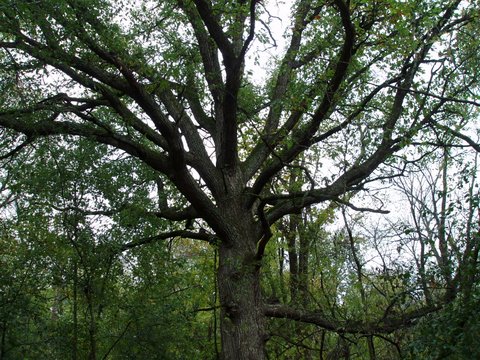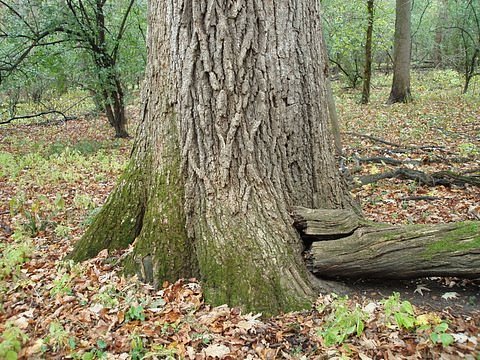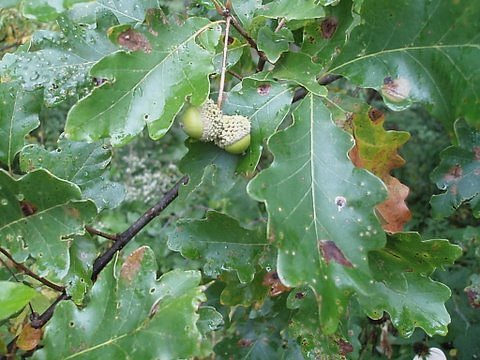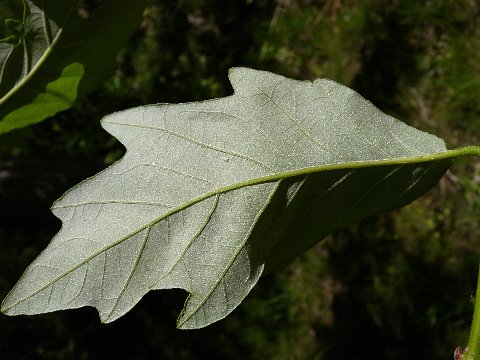
Swamp White Oak is monoecious, producing separate male (staminate) and female (pistillate) flowers on the same tree. The male flowers are produced along drooping catkins about 2-4" long; the male flowers are sparsely distributed along these catkins in small clusters. Each male flower (about 1/8" or 3 mm. in length) consists of several stamens that are embedded within hairy floral bracts. The female flowers are produced from the axils of leaves in clusters of 2-4. Each female flower (about 1/8" or 3 mm. in length) consists of an ovary with usually 3 stigmata; it is embedded within an involucre consisting of hairy floral scales. The blooming period occurs from mid- to late-spring and lasts about 1-2 weeks. The flowers are cross-pollinated by wind. Afterwards, fertile female flowers develop into acorns that become ¾-1" long and ½-¾" across at maturity during the autumn of the same year. Usually, only 1-2 acorns develop near the tip of a long peduncle about ½-4" long, while the pedicel of each acorn is very short (less than 1/8" or 3 mm. long). The cup of a mature acorn is tan-colored or light gray, while its body is brown; the cup extends to about one-third of the length of an acorn. The scales of the cup are somewhat recurved and pointed, rather than appressed together. The white acorn meat is mildly bitter. The woody root system is shallow to moderately deep and widely spreading. During the autumn, the deciduous leaves become brownish yellow, sometimes with patches of orange and red.

Cultivation: The preference is full sun, wet to mesic conditions, and soil containing some combination of loam, clay, silt, or sand. Soil pH should be non-alkaline. Both compaction of the soil and temporary flooded conditions are tolerated. Individual trees can produce acorns in 20-30 years and they may live 300-350 years. Mature acorns will germinate shortly after they have been placed in moist ground.
Range & Habitat: The native Swamp White Oak is occasional in most areas of Illinois, except in the NW section of the state, where it is rare or absent (see Distribution Map). Habitats include floodplain woodlands, edges of swamps, borders of streams, sloughs, poorly drained upland flats, and edges of vernal pools in wooded areas. Swamp White Oak is found with miscellaneous deciduous trees in poorly drained areas, including Green Ash, American Elm, Red Maple, Silver Maple, American Sycamore, Eastern Cottonwood, Pin Oak, Bur Oak, Shellbark Hickory, Sweet Gum, Black Gum, and Black Willow. Sometimes Swamp White Oak is cultivated as a landscape tree in parks and residential areas.

Faunal Associations: The value of Swamp White Oak and other oaks (Quercus spp.) to wildlife is high. A large number of insects are known to use these trees as a source of food by boring through the wood, chewing on the leaves, sucking the sap, etc. They include the larvae of metallic wood-boring beetles, larvae of long-horned beetles, leaf beetles, weevils, larvae of bark beetles, aphids, leafhoppers, treehoppers, armored scales, mealybugs, larvae of gall flies, larvae of gall wasps, larvae of sawflies, plant bugs, stink bugs, walkingsticks, and larvae of the following skippers, butterflies, and moths: tiger moths, ribbed coccoon-making moths, case-bearer moths, Geometer moths, leaf blotch miner moths, Duskywing skipppers (Erynnis spp.), lappet moths, slug caterpillar moths, Hairstreak butterflies (Satyrium spp.), midget moths, owlet moths, prominent moths, giant silk moths, clear-winged moths, trumpet leaf-miner moths, and Tortrix moths. See the Beetle Table, Moth Table, Aphid Table, and Miscellaneous Insect Table for more detailed information about these species. Such insects attract many kinds of insectivorous birds to oak trees. Vertebrate animals feed on various parts of oaks, especially the acorns. Ducks, crows, blackbirds, upland gamebirds, woodpeckers, parakeets, and other birds feed on acorns (see Bird Table). Mammals that feed on acorns include the Gray Fox, White-tailed Deer, Prairie Vole, Meadow Vole, White-footed Mouse, Virginia Opossum, Raccoon, Southern Flying Squirrel, Eastern Gray Squirrel, Fox Squirrel, American Red Squirrel, Eastern Chipmunk, Muskrat (minor), and American Black Bear. The White-tailed Deer also browses on the leaves and twigs, while the Cottontail Rabbit gnaws on the bark of saplings and the American Beaver gnaws on the wood and bark (Martin et al., 1951/1961; Hamerstrom & Blake, 1939; Whitaker, 1966; Beeman & Pelton, 1980). Swamp White Oak and other oak trees provide protective cover for many kinds of wildlife. Such birds as the Red-shouldered Hawk, Cerulean Warbler, Hooded Warbler (saplings), Blue-gray Gnatcatcher, Eastern Wood-pewee, Yellow-throated Vireo, and Field Sparrow (saplings) often use oak trees as nest sites for their young (Dijak et al., 1990; Newell & Rodewald, 2011; Bielefeldt & Rosenfeld, 2001; Best, 1978). The Eastern Screech Owl uses these trees sometimes as roost sites (Belthoff & Ritchison, 1990), while many species of bats use them for both roost sites and sites for maternity colonies. The latter include the Silver-haired Bat, Evening Bat, Big Brown Bat, Hoary Bat, Little Brown Bat, Tricolored Bat, Indiana Bat, and Northern Long-eared Bat (Perry et al., 2010; Perry & Thill, 2008; Swier, 2003; Baerwald et al., 2012; Veilleux et al., 2003; Carter, 2003).

Photographic Location: Photographs of the tree silhouette, tree trunk, and leafy twigs with acorns were taken by Paul Showers (Copyright © 2011) in NE Illinois. The photograph of the leaf undersides was taken by John Hilty near a stream at Meadowbrook Park in Urbana, Illinois.
Comments: Where their ranges overlap, this oak sometimes hybridizes with the Bur Oak (Quercus macrocarpa) and Basket Oak (Quercus michauxii) – all of these oaks prefer bottomland habitats. Swamp White Oak can be distinguished from White Oak (Quercus alba) and Bur Oak by the more shallow lobes of its leaves and their whitened undersides. It differs from Basket Oak by having fewer lobes along the margins of its leaves. Swamp White Oak can be distinguished from these and other oaks by the long peduncles (½-4" in length) of its acorns. Other oaks have shorter peduncles. The wood of Swamp White Oak is relatively heavy, strong, light brown, fine-grained, and rot resistant. It has been used in the construction of furniture, cabinets, interior finishing, flooring, barrels, kegs, crates, boat hulls, rail ties, and fence posts. Compared to White Oak, however, its wood tends to be more knotty from the persistence of lower branches. Oak trees are hosts to many parasitic and symbiotic fungi. Examples of bracket fungi that are found on standing or fallen trunks include Inonotus hispidus (Shaggy Bracket), Daedalea quercina (Oak Mazegill), and Fistulina hepatica (Beefsteak Fungus). In addition, Evernia prunastri (Oakmoss Lichen) and other lichens are often found on oak trees.